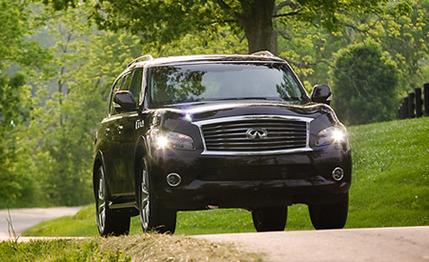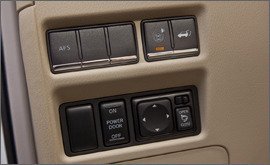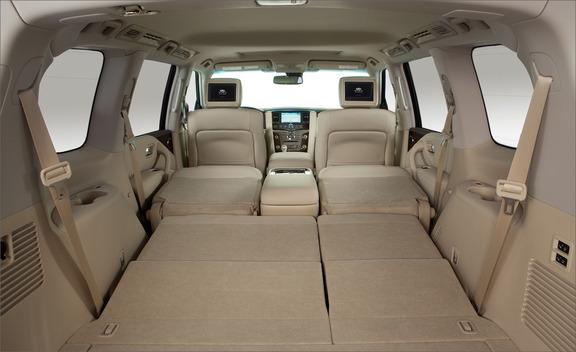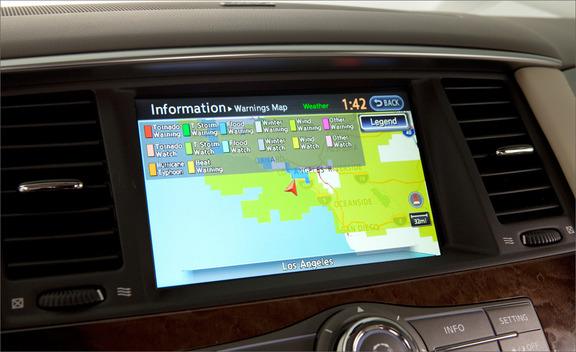
 First Drive Review
First Drive Review
The outgoing Infiniti QX56 was a vehicle that never made much sense to us. After all, you could get almost all of its equipment—save a few electronic trinkets—on the otherwise identical Nissan Armada, and you’d save thousands in the process. But the QX has been redesigned for 2011, migrating to a platform shared with the Nissan Patrol SUV, a Toyota Land Cruiser competitor in the rest of the world. The result is a machine more perfectly suited to its primary mission: ferrying well-off families to and from the vacation house, mall, and celebrity-chef restaurants that serve microhydrogenated candied aardvark liver.
The architecture remains body-on-frame, but you’d never know it from the smooth ride and refined personality of the new QX. Whereas the old Titan-based QX56 was a truckish brute with yesteryear interior tech and a rough-around-the-edges persona, the 2011 version is bristling with up-to-the-minute electronics and a suave character that matches its sleek new exterior.


Our drive route wended through the hollers and hills surrounding Louisville, Kentucky, and we sampled rear- and four-wheel-drive models. Ride quality was equally good on the standard 20-inch wheels or the step-up 22s, although it must be said that the roads in Kentucky were merely lumpy rather than broken and frost-heaved. Once a QX shows up in Michigan, we’ll see if our opinion of the ride holds. The 4WD QX we drove was equipped with a new hydraulic body-control system. The system is similar to that offered in Audi’s RS 5 coupe, in that it feeds hydraulic fluid from shock to shock via a valve system as a means of controlling body motions, and it replaces the anti-roll bars of the base QX. In truth, however, we couldn’t feel much of a difference between the two suspension setups; head toss and body roll were handled equally well in each of the vehicles we drove.
One big difference did exist between the two models, however. In rear-drive and 4WD QXs, the steering is feather light—all the better for freshly manicured desperate housewives—but the feedback is more positive in the two-wheel-drive QX, and on-center stability is better there, too. The 2011 QX’s steering pales in comparison to the rack of the model it replaces, which was pretty lively and talkative for being installed in something the size of Rush Limbaugh’s ego. Of course, steering feel matters to buyers in this segment about as much as whether or not an SUV can turn into a sweet robot with fists made of lasers. We care about both of those things, but really, the new QX’s steering is as good as it needs to be.
Huge, Roomy, and Powerful
The new QX is wider and longer than the outgoing model, but it’s also shorter in height by three inches and has a wheelbase that’s been trimmed by 2.1 inches. Infiniti says weight is down by 160 pounds in comparable 4WD models. Still, this thing is huge, paralleling the immensity of its primary competitors, vehicles like the Mercedes-Benz GL-class and Cadillac Escalade. Being gigantic, the QX56 can accommodate up to eight passengers in its three rows; the second row comes standard with two captain’s chairs and a cavernous center console, and a 60/40-split folding bench is available. The three-person third row is tight versus those of the class leaders, but truthfully, are you ever going to sit in it? No, you’ll shove the kids back there, and they’ll fit fine. Infiniti has thoughtfully added a power recline function to the final row, and it really helps livability.
Even though the QX56 badge carries over, denoting a 5.6-liter engine underhood, the powerplant is new and direct injected. First appearing in the 2011 M56 sedan, this 5.6-liter V-8 makes a highly competitive 400 hp at 5800 rpm and 413 lb-ft at 4000 rpm, up from the old 5.6’s 320 hp and 393 lb-ft. The previous QX used a five-speed automatic, but the 2011 iteration has two more forward ratios. What with the slight weight loss, direct fuel injection, and extra gears, fuel economy is up a couple of mpg to 14 city and 20 highway. The all-wheel-drive system is an evolution of the current truck’s, and it still features an auto setting that can funnel all torque to the rear wheels depending on available traction; a “4 High” setting that locks the torque at 50 percent front and 50 percent rear; and a “4 Low” setting. There no longer is a setting to lock in rear-wheel drive. Maximum towing has decreased from 9000 pounds to 8500, still plenty for towing a boat or a couple of snowmobiles.


Infiniti says the new QX is quicker than its forebear to 60 mph, but you can’t tell much of a difference by the seat of your pants. Still, this is not a slow truck. We tested the last QX to 60 in 7.1 seconds, and it’s shocking how something pushing three tons can get moving that quickly. The exhaust note is as glorious as before, too. The biggest improvement is in overall refinement. The old powertrain was pulled from the Titan pickup truck, and although it was quick and fun, there was a hairiness that’s been ironed out of the new setup, which must now pull double duty in a luxury sports sedan. The power delivery and the gearswaps are silky smooth, and the overall feel is befitting of a luxury vehicle; it suffers from none of the touchy throttle woes of its Infiniti FX stablemate.
A Real Luxury Truck This Time
Refinement is a key word for the interior, too, which is no longer a lowly, plasticky Nissan cabin playing dress-up. This is a true luxury barge now, quiet and stylish inside, with handsome wood (stained with an attractive dark-to-light gradient) trimming the dash and doors, along with stitched leather smeared across the center console, door panels, and center armrest. The gauges are highly legible, and they feature some pretty cool Spirograph-style background graphics. The front seats are very comfortable, and there’s lots of legroom for second-row riders. Acres of glass make everything feel bright and airy, and we like that the dashboard is low. Forward visibility is quite good, although the entry-assist handle on the A-pillar is a little too close for comfort.
Standard equipment includes heated front seats, a power liftgate, three-zone climate controls, Bluetooth and USB connectivity, an eight-inch touchscreen display, navigation, Infiniti’s Around View multicamera monitor, XM satellite radio with NavTraffic and NavWeather, and a Zagat restaurant guide that ties into the nav system. A Theater package can be ordered to get two seven-inch screens mounted in the back of the front-seat headrests; they can handle two different inputs, and a third source can be viewed on the nav screen when the vehicle is in park. Infiniti also has included something it calls a tire-pressure inflation indicator, which piggybacks onto the tire-pressure monitoring system. When owners go to add air to the tire, the inflation indicator flashes the hazard lights all around, including on the side mirrors, as the pressure nears the specified 35 psi, finally beeping the horn when the proper pressure is reached. If you overinflate, you hear an extra honk, and the system then flashes the lights and so on as you let air out.
Buyers first choose rear- or four-wheel drive and then climb the options ladder. The $2450 Theater package is the first rung, and it must be ordered to get the second-row bench (a no-cost substitution at that point) and the $5800 Deluxe Touring package. The DT package includes some pretty handsome 22-inch wheels, the hydraulic body-control system, nicer seat leather, a ventilation function for the front seats, heated outboard second-row seats, and an upgraded climate-control system with odor filtration. Frankly, we’d stop there if it were our money. That’s because the top-rung Technology pack, which requires the DT package, includes all the incessantly beeping nanny items we came to loathe on our long-term FX50S—laser-based cruise control, lane-departure prevention, distance control assist, intelligent brake assist—and only one we like, blind-spot monitoring. It also adds adaptive front headlamps. Infiniti allows you to turn off the overlord-ish tech via a couple buttons, but we figure the $2850 would be better spent on a driving school where QX owners would learn how to stay in their lane, properly use the braking system of their vehicle, and watch the road ahead of them for things they might, you know, hit. Is this really too much to ask?


Hey, while we’re asking for stuff, we’d like to request an explanation for the fender vents. To call them tacky would be an insult to boy-racer wings, LED washer nozzles, and Liberace. It’s a shame, too, since the exterior styling is otherwise pretty rockin’. (To be fair, some editors here aren’t so keen.) Gone is the funky geometry of the Armada-based QX, replaced by taut, athletic styling. The swept-back headlamps, the clean rear end, and the sculpted hood connect this new model to the rest of the Infiniti lineup. The tall greenhouse and the low window sills that cheer up the cabin help the exterior styling, too, combining with door bottoms that curve under the rockers to cut down the visual height of the body sides. Save for the huge disjoint of the fender vents, this is a handsome truck. At least one of the vents is functional; the driver’s-side vent feeds additional air to the intake box, but the other vent is merely open to the fender well.
Cargo volume behind the first row is down by a couple of cubic feet to 95.1, but the space is so cavernous you won’t miss them. The load floor is high, though, and much of the new QX’s lengthening comes from the long rear bumper cover designed to hide the hitch receiver. It creates a huge shelf aft of the hatch frame just begging for stuff to be dragged across it, gouging and scratching the paint. If a clear vinyl covering or bumper plate is on the list of dealer-installed accessories, we’d suggest you order one of them.
Same Pricing, Better Focus
The entry-level rear-wheel-drive QX56 costs $57,650, and a 4WD model starts at $60,750, a smidge higher than last year owing to an $85 hike on the destination charge. The QX is a deal compared with the Escalade, GL550, and Lexus GX460, and you’re getting more truck for your money than before. Yeah, the old QX56 was a little friskier, a little more fun to drive, and a little more capable. But this new one is more powerful, much more luxurious, and much more likely to cause a splash at the country club. Although huge V-8–powered, body-on-frame luxury SUVs aren’t exactly in step with the times, the 2011 QX56 is much more in step with its mission. Of course, we wish that included turning into a sweet robot with fists made of lasers. Maybe for the third generation?